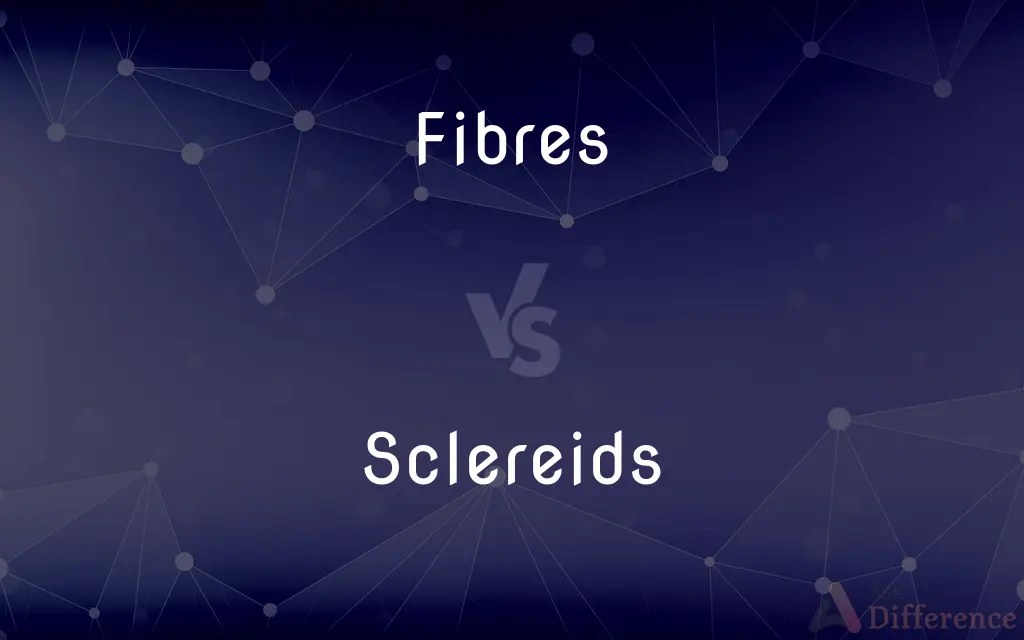Fibres vs. Sclereids — What's the Difference?
By Tayyaba Rehman — Published on January 18, 2024
Fibres are elongated, thread-like plant cells that provide strength and support, while sclereids are short, irregular cells that contribute to hardness in plant tissues.

Difference Between Fibres and Sclereids
Table of Contents
ADVERTISEMENT
Key Differences
Fibres in plants are elongated, supportive cells that are primarily involved in providing tensile strength and flexibility. They are commonly found in the vascular system of plants, aiding in the transport of water and nutrients. Sclereids, on the other hand, are a type of sclerenchyma cell known for their hardness and irregular shape. They are primarily involved in providing mechanical support and deterring herbivory.
The structure of fibres is characterized by their long, slender shape and thick cell walls, which are rich in cellulose and lignin. This structure makes them strong and durable. Sclereids, in contrast, are shorter and can vary greatly in shape, often appearing star-shaped, branched, or rounded. They have extremely thick, lignified cell walls, contributing to the hardness of certain plant parts like nutshells and seed coats.
Functionally, fibres are crucial in the growth and development of plants, especially in stems, roots, and leaves where they provide structural integrity. Sclereids, while also providing support, are more specialized for protection against physical damage and predation, as seen in the gritty texture of pear fruit and the toughness of seed coats.
In terms of distribution, fibres are widespread throughout various parts of a plant, including bark, wood, and leaves. They are particularly abundant in plants used for fiber production, such as cotton and flax. Sclereids are more sporadically distributed, often localized in specific areas where hardness or protection is required.
In summary, both fibres and sclereids are types of sclerenchyma cells in plants, but they differ significantly in shape, structure, function, and distribution. Fibres are long and flexible, contributing to the plant's tensile strength, while sclereids are short and hard, providing protection and rigidity.
ADVERTISEMENT
Comparison Chart
Shape
Elongated, thread-like
Short, irregular, often star-shaped
Primary Function
Providing strength and flexibility
Contributing to hardness and protection
Location in Plants
Throughout the plant, especially in vascular tissues
Localized in specific parts like seed coats and fruits
Cell Wall Composition
Thick, rich in cellulose and lignin
Extremely thick and heavily lignified
Role in Plant Development
Crucial in overall growth and development
Specialized for protection and deterring herbivory
Compare with Definitions
Fibres
Elongated cells contributing to the tensile strength of plants.
The fibres in the bamboo give it remarkable flexibility.
Sclereids
Hard, lignified cells found in nuts and seeds.
The hardness of walnut shells is due to sclereids.
Fibres
Plant cells that are long and slender, providing structural support.
Cotton fibres are used extensively in the textile industry.
Sclereids
Short, irregular plant cells contributing to hardness.
Sclereids give pear fruits their gritty texture.
Fibres
Structural components in plants, rich in cellulose.
Paper is made from the cellulose fibres of trees.
Sclereids
Variously shaped cells providing rigidity to plant parts.
The sclereids in the stem contribute to its toughness.
Fibres
Supportive cells that aid in the transport of nutrients and water.
The fibres in plant stems help in conducting water.
Sclereids
Protective plant cells with thick, tough walls.
Sclereids in seed coats protect the seeds from damage.
Fibres
Strong, thread-like cells in plants.
Flax fibres are known for their durability and strength.
Sclereids
Cells specialized for deterring herbivory and physical damage.
Sclereids in leaves discourage animals from eating them.
Fibres
Variant of fiber.
Sclereids
A thick-walled lignified sclerenchyma cell. Sclereids are variable in shape and are shorter than fibers.
Fibres
Plural of fibre
Sclereids
Plural of sclereid
Common Curiosities
What are sclereids?
Sclereids are short, irregularly shaped plant cells known for their hardness and protective function.
Where are sclereids commonly found?
Sclereids are commonly found in parts of plants that require hardness, such as seed coats and nutshells.
What are plant fibres?
Plant fibres are elongated cells that provide structural support and flexibility to plants.
What is the main function of fibres in plants?
The main function of fibres is to provide strength, flexibility, and support to various plant parts.
Can fibres be used in industrial applications?
Yes, fibres like cotton and flax are widely used in textiles and other industries.
Do sclereids contribute to a plant's growth?
Sclereids contribute more to protection and rigidity than to growth.
Are fibres and sclereids found in all plants?
Most plants have fibres and sclereids, but their abundance and distribution vary greatly.
How do fibres differ from sclereids in shape?
Fibres are long and thread-like, while sclereids are short and can have various shapes, like star-shaped or branched.
What makes fibres strong?
The strength of fibres comes from their cellulose and lignin-rich cell walls.
Are sclereids visible to the naked eye?
Generally, sclereids are not visible to the naked eye unless they form large aggregates.
Is the presence of fibres beneficial for plants?
Yes, fibres are crucial for the structural integrity and overall health of plants.
Do sclereids have any economic importance?
Sclereids are not typically used economically like fibres, but they are important for the quality and protection of certain plant products.
Are fibres and sclereids important for plant survival?
Yes, both fibres and sclereids play important roles in plant survival and functionality.
Do all fibres have the same properties?
No, fibres can vary in their properties depending on the plant source and type.
Can sclereids be found in fruits?
Yes, sclereids are often found in fruits, like the gritty cells in pears.
Share Your Discovery

Previous Comparison
RB67 vs. RZ67
Next Comparison
Serial Transmission vs. Parallel TransmissionAuthor Spotlight
Written by
Tayyaba RehmanTayyaba Rehman is a distinguished writer, currently serving as a primary contributor to askdifference.com. As a researcher in semantics and etymology, Tayyaba's passion for the complexity of languages and their distinctions has found a perfect home on the platform. Tayyaba delves into the intricacies of language, distinguishing between commonly confused words and phrases, thereby providing clarity for readers worldwide.













































